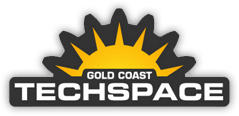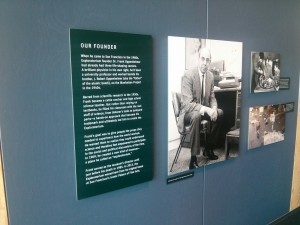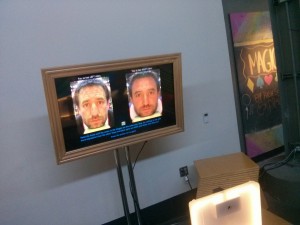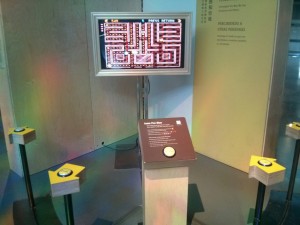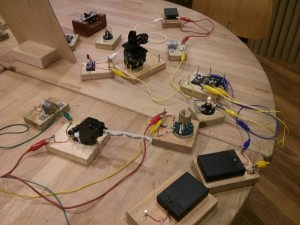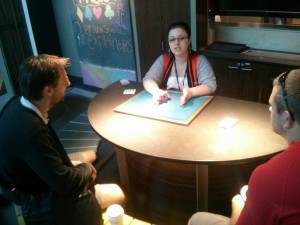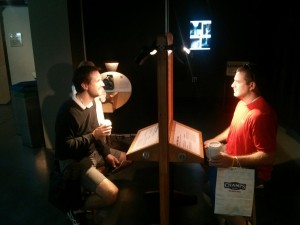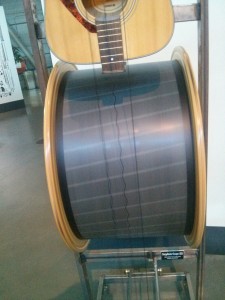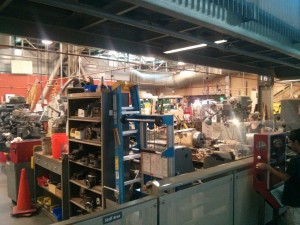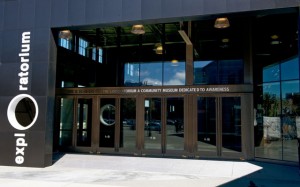 During our recent visit to San Francisco and Silicon Valley, Cn Glen Tozer and myself had the pleasure of visiting the San Francisco Exploratorium, There’s a fair bit of relevance and interest to Makers so I thought it was worthy of a blog post here.
During our recent visit to San Francisco and Silicon Valley, Cn Glen Tozer and myself had the pleasure of visiting the San Francisco Exploratorium, There’s a fair bit of relevance and interest to Makers so I thought it was worthy of a blog post here.
The Exploratorium is located at Pier 15 in the heart of San Francisco – it was founded by Physicist Frank Oppenheimer… you might recognise that surname – he and his brother Robert worked on the Manhatten Project where the first nuclear bombs were (sadly) created!
Anyway – to cut a long story short, Oppenheimer was forced to leave academia and ended up working with schools and that’s where he got into kids science education and museums in particular. He became a very hands on Science teacher and was a strong believer in Museums being hands-on.
This shows through in the Exploratorium… everything in the museum is about exploration. There are over 600 exhibits, each teaching you something new in a hands-on way. It’s fun for both kids and adults and is best shared with friends.
I’ll summarize some of the most interesting aspects of the museum here.
I see Arduino. I see PI!
There are some great exhibits at the Exploratorium and here are a couple of my favourites in the photos below: Left/Right face combination and coordinated pacman. However, when you start decomposing them – many could be accomplished with 2 stalwarts of any Hackerspace…. Arduino & Raspberry Pi.
The 2 above are definitely PI projects – but I also looked inside a lot of the other exhibits and saw quite a few Arduinos as brains!
Electronics Tinker Area
The Exploratorum had an awesome tinker area – a great big table in the middle with a load of buttons and actuators (all connected with croc clips).
When I got there – it was empty, so I sat down and started tinkering. Within 5 minutes a load of kids sat down too and I got many parents asking me questions, they thought I worked there – I didn’t bother to spolt the fun by telling them I was a visitor too!
This area also had vending machines containing lots of easy to use maker kits for kids. Not all of them were electronics – some contained glue and wood and more mechanical projects. I love vending machines…. such a great way for people to grab an instant project they can try at home without having to visit a store.
There is also a store at the Exploratorium … which was brilliant. The staff actually knew what they were talking about too. I bought a really cool fingerprint painting kit for my daughter and a little robot for my son.
Young Adults and Kids as Explainers
Throughout the museum were people helping out – the majority of the people that we saw were High School Kids (and some Uni Students) – known as “Explainers“.
They did an awesome job of it (Glen and I sat through a disgusting and brilliant dissection of a cow’s eye!) and were a credit to the Museum. I couldn’t help also thinking “what an awesome experience for them interacting with the public like this”. Experiences like these foster great leadership skills and there’s no better way to learn something that tell it!
I was also sad that most kids in Australia probably will never get an opportunity like this. Most museums I have been to in Australia seem bereft of people apart from security guards and the visitors!
Low Tech Exhibits Too
Not all the exhibits were technology based, a magician doing card tricks and talking about illusion was pretty popular, and the face combination trick pictured below using prisms was very clever (Glen and his friend were a bit freaked out by their genetic splicing!)
One of my favourite exhibits was this demonstration of vibrating strings on a guitar. The drum behind the strings is painted with white horizonal lines and when you spin it it has the effect of a stroboscope, reproducing a favorite class room experiment of mine.
A foot pedal allows you to change the tension of the strings whilst spinning the wheel with your hands. Whilst I played with it, I explained to a few onlookers (kids and adults) what harmonic frequencies and standing waves were – I was surprise how few people knew what they were (even one guy who was a guitarist!)
A MakerSpace within
The Exploratorium has a lot of exhibits and they seem to be constantly adding and refreshing these. Things also obviously break down and they need to be fixed.
In any other place this might be a backroom, basement or off-site facility, but not at The Exploratorium – they have put the machine shop right slap bang in the middle of the museum in full view. Genius.
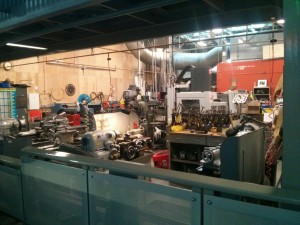 It was great to see people in there working on exhibits and there were an impressive array of machines. A lot of metalwork machinery such as lathes and drill-presses but I also saw 3D printers, laser cutters, extruders, spray painting machines and probably a lot more.
It was great to see people in there working on exhibits and there were an impressive array of machines. A lot of metalwork machinery such as lathes and drill-presses but I also saw 3D printers, laser cutters, extruders, spray painting machines and probably a lot more.
As I watched – it occurred to me…..
“What a great way to build a museum!”
- Take a big building where you want your museum
- Set aside an area in the middle for a makerspace (taking say 20% of the floor space)
- Give the makers some tools and equipment. These could be purchased from initial funding, you could ask for donations or obtain them from other places such as TAFEs that are closing.
- Get a few exhibits from other museums on loan or gifted (many museums do not have enough space for their exhibits).
- NOW! Task the Makerspace members with making some museum exhibits and build the museum out gradually from the centre!
I believe this is a great way to build a museum in a relatively lean way and at the same time give a Makerspace an endless supply of projects and purpose. There’s nothing like SHIPPING your project and having projects on display in the museum would be great motivation for all.
Speaking of which, our very own Makerspace on the Gold Coast, Gold Coast TechSpace will be homeless in a few weeks and we are looking for a long term and sustainable home.
So if anyone reading this wants to help us out please get in touch.
